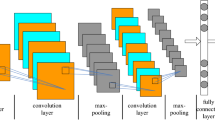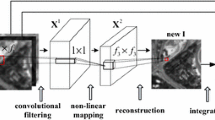Abstract
In remote sensing image fusion field, traditional algorithms based on the human-made fusion rules are severely sensitive to the source images. In this paper, we proposed an image fusion algorithm using convolutional neural networks (FusionCNN). The fusion model implicitly represents a fusion rule whose inputs are a pair of source images and the output is a fused image with end-to-end property. As no datasets can be used to train FusionCNN in remote sensing field, we constructed a new dataset from a natural image set to approximate MS and Pan images. In order to obtain higher fusion quality, low frequency information of MS is used to enhance the Pan image in the pre-processing step. The method proposed in this paper overcomes the shortcomings of the traditional fusion methods in which the fusion rules are artificially formulated, because it learns an adaptive strong robust fusion function through a large amount of training data. In this paper, Landsat and Quickbird satellite data are used to verify the effectiveness of the proposed method. Experimental results show that the proposed fusion algorithm is superior to the comparative algorithms in terms of both subjective and objective evaluation.













Similar content being viewed by others
References
Amro I, Mateos J, Vega M et al (2011) A survey of classical methods and new trends in pansharpening of multispectral images. EURASIP J Adv Signal Process 79:1–22. https://doi.org/10.1186/1687-6180-2011-79
Burt PJ, Adelson EH (1983) The Laplacian pyramid as a compact image code. IEEE Trans Commun COM-31(4):532–540
Cheng J, Liu H, Liu T et al (2015) Remote sensing image fusion via wavelet transform and sparse representation. ISPRS J Photogramm Remote Sens 104:158–173
Choi M, Kim RY, Nam MR, Kim HO (2005) Fusion of multispectral and panchromatic satellite images using the curvelet transform. IEEE Geosci Remote Sens Lett 2(2):136–140
Chu H, Zhu W (2008) Fusion of IKONOS satellite imagery using IHS transform and local variation. IEEE Geosci Remote Sens Lett 5(4):653–657
Collobert R (2011) Natural language processing (almost) from scratch. J Mach Learn Res 12:2493–2537
Do MN, Vetterli M (2005) The contourlet transform: an efficient directional multiresolution image representation. IEEE Trans Image Process 14(12):2091–2106
Fan C, Wang L, Liu P et al (2016) Compressed sensing based remote sensing image reconstruction via employing similarities of reference images. Multimed Tools Appl 75(19):12201–12225
Gangkofner UG, Pradhan PS, Holcomb DW (2008) Optimizing the high pass filter addition technique for image fusion. Photogramm Eng Remote Sens 74(9):1107–1118
Ghahremani M, Ghassemian H (2015) Remote-sensing image fusion based on Curvelets and ICA. Int J Remote Sens 36(16):4131–4143
Ghassemian H (2016) A review of remote sensing image fusion methods. Inform Fusion 32(PA):75–89
Global Land Cover Facility. http://www.landcover.org/. Accessed 11 Nov 2018
González-Audícana M, Saleta JL, Catalán RG et al (2004) Fusion of multispectral and panchromatic images using improved IHS and PCA mergers based on wavelet decomposition. IEEE Trans Geosci Remote Sens 42(6):1291–1299
Hinton GE, OsinderoS TYW (2006) A fast learning algorithm for deep belief nets. Neural Comput 18(7):1527–1554. https://doi.org/10.1162/neco.2006.18.7.1527
Hnatushenko VV, Vasyliev VV (2016) Remote sensing image fusion using Ica and optimized wavelet transform. Int Arch Photogramm Remote Sens Spat Inf Sci XLI-B7:653–659
Ji X, Zhang G (2017) Image fusion method of SAR and infrared image based on Curvelet transform with adaptive weighting. Multimed Tools Appl 76(17):17633–17649
Kong WW, Lei YJ, Lei Y et al (2011) Image fusion technique based on non-subsampled contourlet transform and adaptive unit-fast-linking pulse-coupled neural network. IET Image Process 5(2):113–121
Krizhevsky A, Sutskever I, Hinton G (2012) ImageNet classification with deep convolutional neural networks. In proc. Adv Neural Inf Proces Syst 25:1090–1098
Liu Y, Wang Z (2014) A practical pan-sharpening method with wavelet transform and sparse representation. IEEE international conference on imaging systems and techniques, 288–293
Luo Y, Liu R, Zhu YF (2011) Fusion of remote sensing image base on the PCA + ATROUS wavelet transform. Appl Mech Mater 353-356:172–176
Nakazawa T, Kulkarni DV (2018) Wafer map defect pattern classification and image retrieval using convolutional neural network. IEEE Trans Semicond Manuf 31(2):309–314
Paramanandham N, Rajendiran K (2017) Multi sensor image fusion for surveillance applications using hybrid image fusion algorithm. Multimed Tools Appl. https://doi.org/10.1007/s11042-017-4895-3
Park CC, Kim Y, Kim G (2018) Retrieval of sentence sequences for an image stream via coherence recurrent convolutional networks. IEEE Trans Pattern Anal Mach Intell 40(4):945–957
PohlC V (1998) Multisensor image fusion in remote sensing: concepts, methods and applications. Int J Remote Sens 19(5):823–854
Shah VP, Younan NH, King RL (2008) An efficient pan-sharpening method via a combined adaptive PCA approach and contourlets. IEEE Trans Geosci Remote Sens 46(5):1323–1335
Shahdoosti HR, Ghassemian H (2015) Fusion of MS and PAN images preserving spectral quality. IEEE Geosci Remote Sens Lett 12(3):611–615
Shahdoosti HR, Ghassemian H (2016) Combining the spectral PCA and spatial PCA fusion methods by an optimal filter. Information Fusion 27:150–160
Shensa MJ (1992) The discrete wavelet transform: wedding the àtrous and Mallat algorithm. IEEE Trans Signal Process 40(10):2464–2482
Sutskever I, Vinyals O, Le QV (2014) Sequence to sequence learning with neural networks. Adv Neural Inf Proces Syst 27:3104–3112
Tu TM, Su SC, Shyu HC et al (2001) A new look at ihs-like image fusion methods. Inform Fusion 2(3):177–186
Tu TM, Huang PS, Hung CL et al (2004) A fast intensity-hue-saturation fusion technique with spectral adjustment for IKONOS imagery. IEEE Geosci Remote Sens Lett 1(4):309–312
Valizadeh SA, Ghassemian H (2012) Remote Sensing image fusion using combining HIS and Curvelet transform. In: International symposium on telecommunications, 1184–1189
Wu B, Fu Q, Sun L et al (2015) Enhanced hyperspherical color space fusion technique preserving spectral and spatial content. J Appl Remote Sens 9(1):097291
Yang Y, Wan W, Huang S et al (2017) Remote sensing image fusion based on adaptive IHS and multiscale guided filter. IEEE Access 4:4573–4582
Zhang X, Li X, Feng Y (2017) Image fusion based on simultaneous empirical wavelet transform. Multimed Tools Appl 76(6):8175–8193
Acknowledgements
The work was supported by National Science & Technology Pillar Program of China (Grant No. 2012BAH48F02), National Natural Science Foundation of China (Grant No. 61272209, 61801190), Natural Science Foundation of Jilin Province (Grant No. 20180101055JC), Outstanding Young Talent Foundation of Jilin Province (Grant No. 20180520029JH) and China Postdoctoral Science Foundation (Grant No. 2017M611323). The authors would like to thank Dr. Shuang Yu for her help on technical editing of the manuscript, and Prof. Xiaoying Sun for scientific advices.
Author information
Authors and Affiliations
Corresponding author
Additional information
Publisher’s Note
Springer Nature remains neutral with regard to jurisdictional claims in published maps and institutional affiliations.
Rights and permissions
About this article
Cite this article
Ye, F., Li, X. & Zhang, X. FusionCNN: a remote sensing image fusion algorithm based on deep convolutional neural networks. Multimed Tools Appl 78, 14683–14703 (2019). https://doi.org/10.1007/s11042-018-6850-3
Received:
Revised:
Accepted:
Published:
Issue Date:
DOI: https://doi.org/10.1007/s11042-018-6850-3




